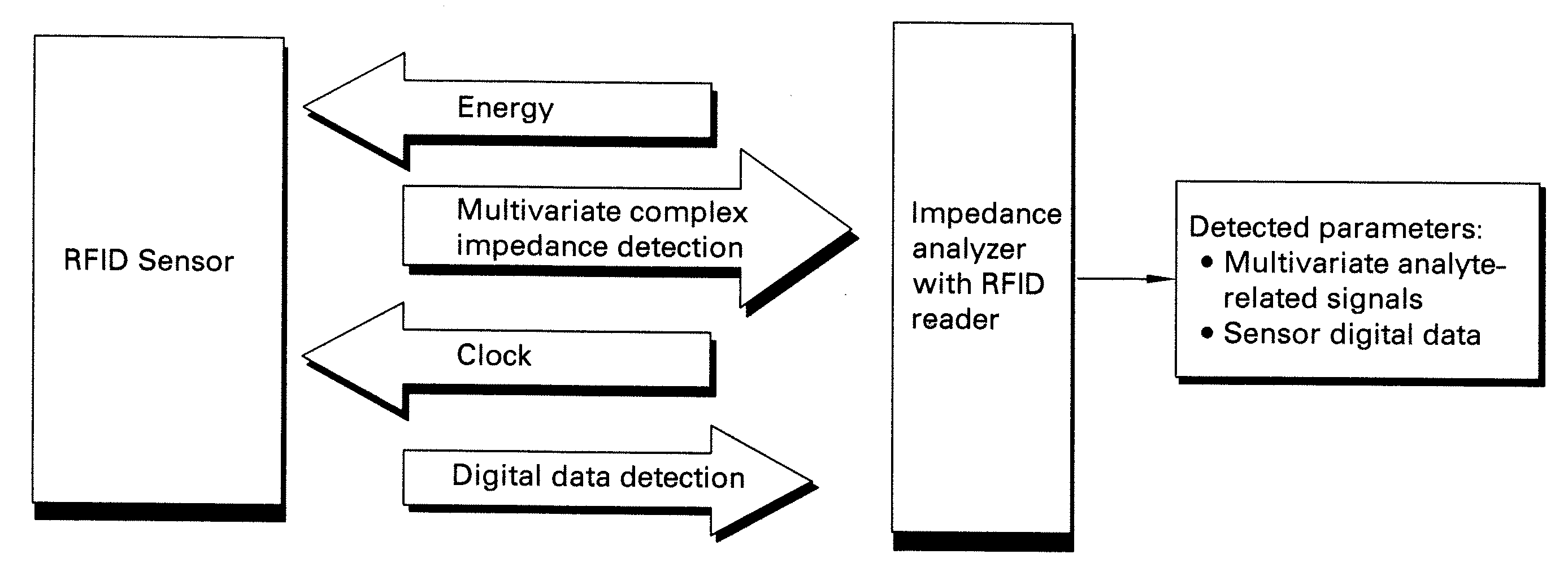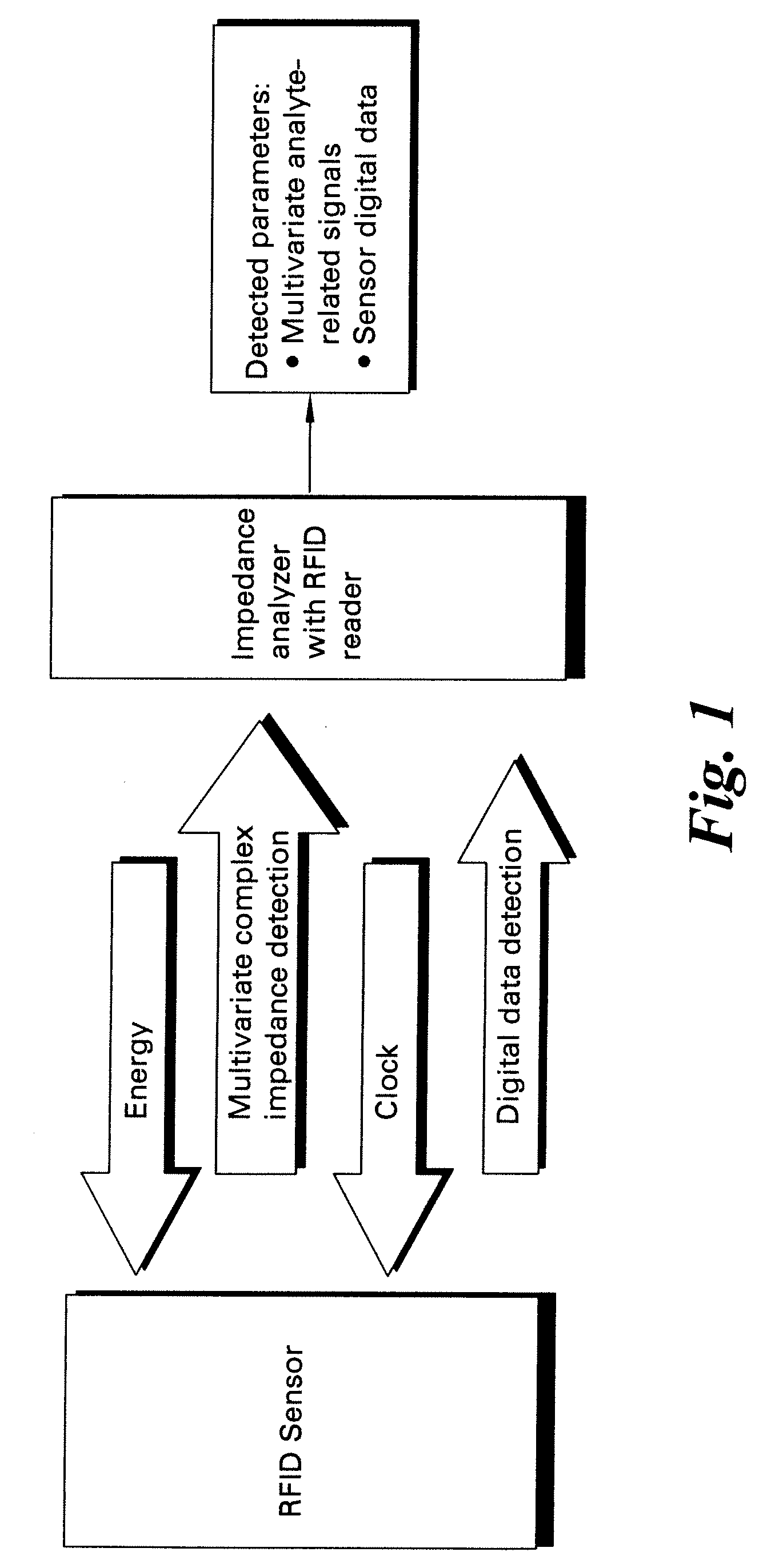Methods and systems for calibration of RFID sensors
- Summary
- Abstract
- Description
- Claims
- Application Information
AI Technical Summary
Benefits of technology
Problems solved by technology
Method used
Image
Examples
example 1
Calibration Based on Measurements of Complex Impedance
[0064]Passive 13.56 MHz RFID tags (Texas Instruments) were used for temperature sensing and for demonstration of the disclosed calibration methods. Digital ID of the RFID sensors was read with a Skytek reader. Seven RFID sensors were used with the read IDs shown in Table 1.
TABLE 1Digital IDs of the employed RFID sensorsSensorNumberDigital IDCommentsS1E007 000 0219 24E9Replicate measurements (n = 4) oftemperature responseS2E007 000 0219 24E8Replicate measurements (n = 2) oftemperature responseS3E007 000 0219 24E3No complex impedance measurementsdoneS4E007 000 0219 24E7Replicate measurements (n = 2) oftemperature response, used forblind calibrationS5E007 000 0219 24E5Replicate measurements (n = 2) oftemperature responseS6E007 000 0219Replicate measurements (n = 2) of24DAtemperature response
[0065]Measurements of the complex impedance of the RFID sensor were performed with a network analyzer (Model E5062A, Agilent Technologies) and a...
example 2
Measurement of Multiple Parameters Using a Single RFID Sensor
[0071]A single RFID sensor may be used to independently determine more than one parameter. A Texas Instruments RFID tag was adapted for sensing of temperature and solution conductivity by laminating the RFID tag to a polymer film. Measurements of the complex impedance of the resulting RFID sensor were performed with a network analyzer (Model E5062A, Agilent Technologies, Inc. Santa Clara, Calif.) under computer control using LabVIEW. The network analyzer was used to scan the frequencies over the range of interest and to collect the complex impedance response from the RFID sensors. Adding NaCl salt into a vessel to which the RFID sensor was attached produced solution conductivity changes. Positioning the entire vessel and the RFID sensor into an environmental chamber where the temperature was incrementally increased from 5 to 60° C. changed the temperature.
[0072]FIG. 12A shows variations in the measured responses (Fp and Zp...
example 3
Discrimination of Chemical and Physical Measured Parameters Using a Single Complementary RFID Sensor
[0073]The operation of a complementary sensor that exhibits a simultaneous resistance and capacitance change can be used to discriminate between different parameters of interest. These parameters of interest affect the sensor response in diverse ways, such that it is possible to selectively measure one or more parameters
[0074]A combination humidity and temperature RFID sensor was fabricated by attaching a complementary sensor to an RFID tag. A humidity sensor (Vaisala Inc.) was attached to a Texas Instruments RFID tag across its antenna. The humidity sensor from Vaisala Inc. is a capacitor structure filled with a humidity sensitive polymer. The dielectric property of the humidity sensitive polymer changes as a function of humidity. However, these changes are also temperature sensitive. Thus, if a single response is measured from the RFID sensor, temperature and humidity effects on the...
PUM
 Login to View More
Login to View More Abstract
Description
Claims
Application Information
 Login to View More
Login to View More - R&D
- Intellectual Property
- Life Sciences
- Materials
- Tech Scout
- Unparalleled Data Quality
- Higher Quality Content
- 60% Fewer Hallucinations
Browse by: Latest US Patents, China's latest patents, Technical Efficacy Thesaurus, Application Domain, Technology Topic, Popular Technical Reports.
© 2025 PatSnap. All rights reserved.Legal|Privacy policy|Modern Slavery Act Transparency Statement|Sitemap|About US| Contact US: help@patsnap.com



